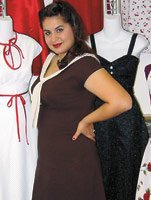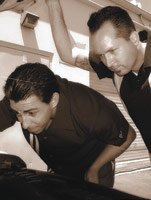Past Perfect: Retro Designers See Business Boom
After several years of bare midriffs, a handful of Southern California labels are finding increasing demand for retro designs that are anything but provocative.
The vintage look has its roots in the swing scene of the 1990s. The scene peaked in 1999, but not before its proponents noticed an annoying problem with vintage clothing. While vintage dresses and suits were cheap and fashionable, the fragility of the 50-year-old fabric made them ill-suited for the aerobics of swing dancing. What was needed were dresses that offered a vintage look with modern durability. A slew of new designers emerged, armed with old Vogue pattern books and newly acquired sewing skills.
These days, the vintage look is experiencing a revival, and some retro labels have seen sales quadruple over the last year.
Los Angeles-based Stop Staring, founded by designer Alicia Estrada, started nine years ago as a maker of vintage-style lingerie. Now specializing in 1940s- and 1950s-style dresses, the brand posted a gross revenue of roughly $250,000 in 2002. This year, Estrada hopes to hit $1 million.
Stop Staring’s dramatic sales increase began last August, when Estrada attended her first MAGIC International show in Las Vegas.
“Once that happened, things skyrocketed,” she said.
Chain stores Windsor Fashions, Hot Topic and Hot Topic’s plus-size sister store, Torrid, have picked up the brand.
“The merchandise is very authentic looking and has a lot of credibility,” said Hot Topic general merchandise manager Cindy Levitt, who said customers have specifically requested the Stop Staring brand. Hot Topic is testing the brand in about 25 stores in California, Arizona and Texas.
According to Estrada, MAGIC buyers said her dresses were not just limited to a small subculture of retrophiles suffering from modern-itis. Instead, they saw her designs as classic and as having a broad appeal that crossed generations.
Indeed, Estrada is more interested in being timeless than trendy.
“We’ve been doing this for six years,” she said. “If it was a trend, I’m sure it’d be over by now.”
Several resort stores have picked up Stop Staring’s perennial sundresses, and Windsor intends to market Stop Staring’s designs as special-occasion dresses, according to Estrada.
The collection, which is wholesale priced between $29 and $59, includes details such as full linings and clean seams. Retailers have more than 200 designs to choose from, according to Estrada.
It was serendipitous that the swing revival occurred in tandem with the rise of the Internet, which helped fuel sales for many retro designers. Since its inception, Stop Staring has seen its Web page, stopstaringclothing.com, drive its sales growth.
Indiana-based Daddy-O’s, daddyos.com, is the biggest online retailer of retro clothing for men and women. It has sold the Stop Staring line for five years and moves about 350 of its dresses per month.
“[Estrada’s] stuff is the most feminine of the reproduction stuff,” said Daddy-O’s co-owner, Christy Berry. “She uses really pretty fabrics.”
Inspiration from the 1950s
Another top line at Daddy O’s is Santa Ana, Calif.-based Steady Clothing, which specializes in 1950s-style bowling shirts for men.
Like Stop Staring, Steady Clothing has also experienced tremendous growth during the last few years. The company expects to hit $4 million in sales this year, according to Steady Clothing vice president Joshua Brownfield.
Steady Clothing is in about 600 boutiques nationwide. Its 18- to 35-year-old target customer runs the gamut from surf/skate youth to the casual male.
“But definitely someone with a sense of style,” said Brownfield.
That includes ex-Stray Cats rocker Brian Setzer, who has Steady Clothing make all his merchandise and stage outfits.
The brand was founded in 1994 and added a women’s line two years ago. The first year Steady Clothing offered women’s clothes, the line—primarily tops and pants—accounted for 10 percent of the company’s sales. Now, the women’s clothing accounts for 30 percent of sales.
One of the brand’s trademarks is its picture buttons, in which a Kodak image—such as a pair of dice for the guys or a cherry for the girls—is pressed into shirt buttons.
Men’s button-ups wholesale from $21 to $26, and the women’s line runs from $17 to $24.
Like other retro designers, Brownfield does not see retro as a roadblock to success. Steady Clothing has been able to prosper with little compromise and remain true to its aesthetic and home-grown ideals.
“Retro is really just clean and simple,” Brownfield said. “And being made in the U.S. has been a big push. When everybody else started losing business about a year ago, we doubled because everything’s made here. Our turnaround is incredible: two to three weeks.”
Some brands are retro without even trying. The Da Vinci label was founded in Los Angeles in 1952 and continued to exist long past its prime as a purveyor to Palm Springs retirees. The brand was bought six years ago by enthusiastic British expatriate Christopher Wicks, who admits he paid “too much” for the company— but couldn’t help himself.
The immense archives the company passed on to Wicks sweetened the deal. He now draws strongly on the brand’s original designs and milks every last drop of coolness from Da Vinci’s Rat Pack connotations and golden-age hipster clientele.
Da Vinci is in American Rag, Urban Outfitters and Fred Segal, and Wicks said his European distributor is doing particularly well. He is currently entertaining offers from various department stores and has just signed a licensing deal with guitar maker Fender. The wholesale price range for the line is $26–$35, and women’s clothing makes up about 20 percent of the company’s sales.
Timeless Classics
There’s a vintage vibe running through the collections of highend designers such as Marc Jacobs, notes Los Angeles stylist Jenna Kautzky, although she notes that Jacobs’ Fall line has “more of a late ’50s—early ’60s look.”
“’West Side Story’ seems to be the look right now,” she said. “It’s a little low key— it’s not the hat and the gloves—it’s more of a streetwear fem.”
Current silhouettes include shirtwaist dresses with fuller skirts, pencil skirts, Capri pants and flat shoes with a pointed toe, Kautzky said.
Melanie Schmidt, owner of Los Angelesbased label Dixiefried, welcomes the return to femininity she sees in current lines by Marc Jacobs, Donna Karan and Louis Vuitton.
“It’s been good for me,” she said. “I’ve definitely felt it this season.”
Dixiefried, which launched four years ago, sells its own and a few other small retro lines from its shop in Los Angeles’ Silver Lake district. Dresses wholesale from $29 to $36, and wardrobe staples, such as pencil skirts and capri pants, also sell out as soon as they come in.
Buyers are starting to see Dixiefried clothing less as a retro line and more as an inexpensive version of what star designers are showing on the runway, according to Schmidt. That helps keep Dixiefried from being pigeonholed as simply a maker of rockabilly fashions.
Schmidt said she tries to keep her clothing from looking “costumey” and makes sure everything can blend easily with contemporary outfits.
“I don’t like it when you look like an extra on ’I Love Lucy,’” she said.
























